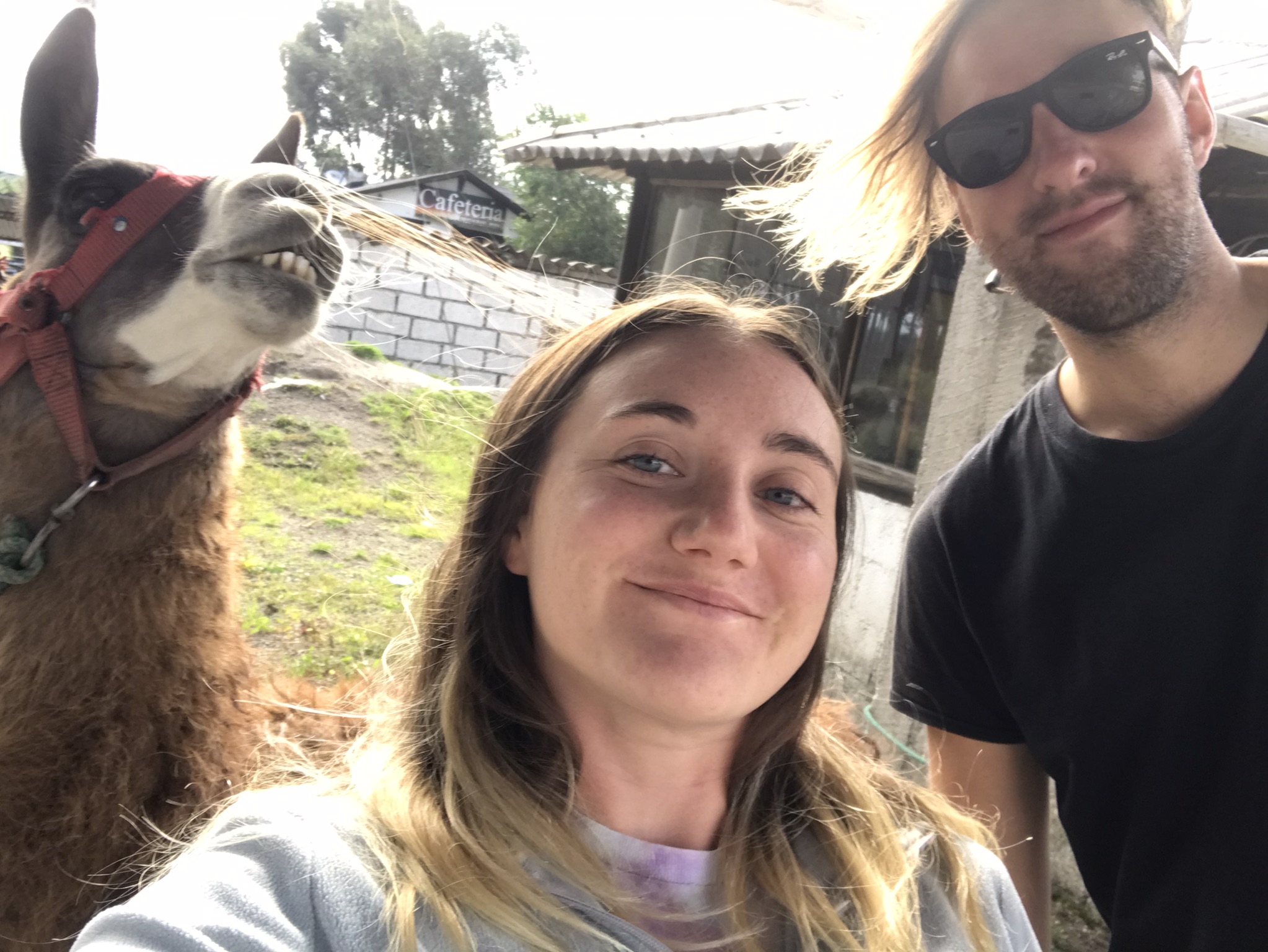Panama is sandwiched between the Caribbean Sea to the north and Pacific Ocean to the south, sitting on a west-east configuration. It borders Costa Rica to the west and Colombia to the east, via the perilous Darian gap. With large swathes of untouched jungle and only a few major cities, Panama is one of the only carbon-negative countries in the world. Despite this, Panama City is a glitzy, skyscraper-laden metropolis that seems like a different world to the rest of the country and even the rest of Central America. Read on for my Panama travel experiences below!
Boquete, Bocas del Toro, David, Panama City
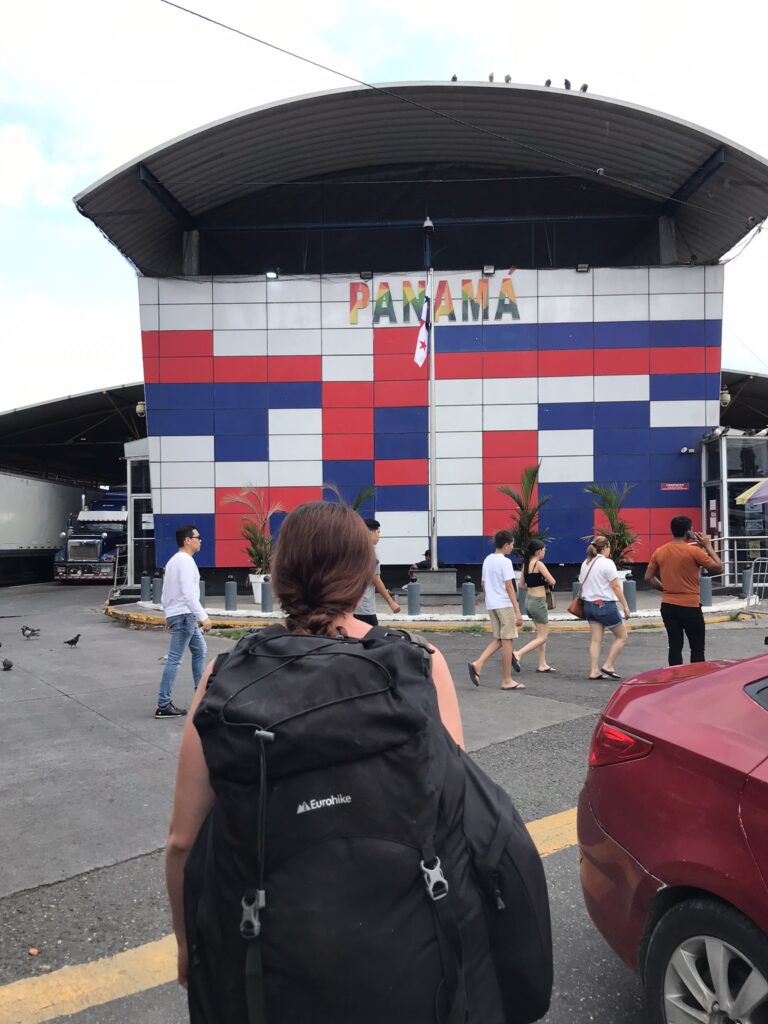
Panama acts as a land bridge between North and South America. It was formed about 3 million years ago, damming the Pacific Ocean and Caribbean Sea. Early groups of humans used Panama to cross from the North American continent to South America, establishing trade and migration routes. According to most geographers, the Panama Canal is the demarcation line between North and South America.
Panama is a land of contradictions, from in-your-face wealth and glitzy skyscrapers in the financial district of Panama City to weathered wooden clapboard cabins on stilts in the Bocas del Toro region. Poverty and excess are ever-present in modern Panama. Life is good for some whilst for others it’s a daily struggle to make ends meet. Some estimates suggest up to 25% of Panamanians live in poverty, with higher rates among indigenous and afro-Panamanians living in rural areas.
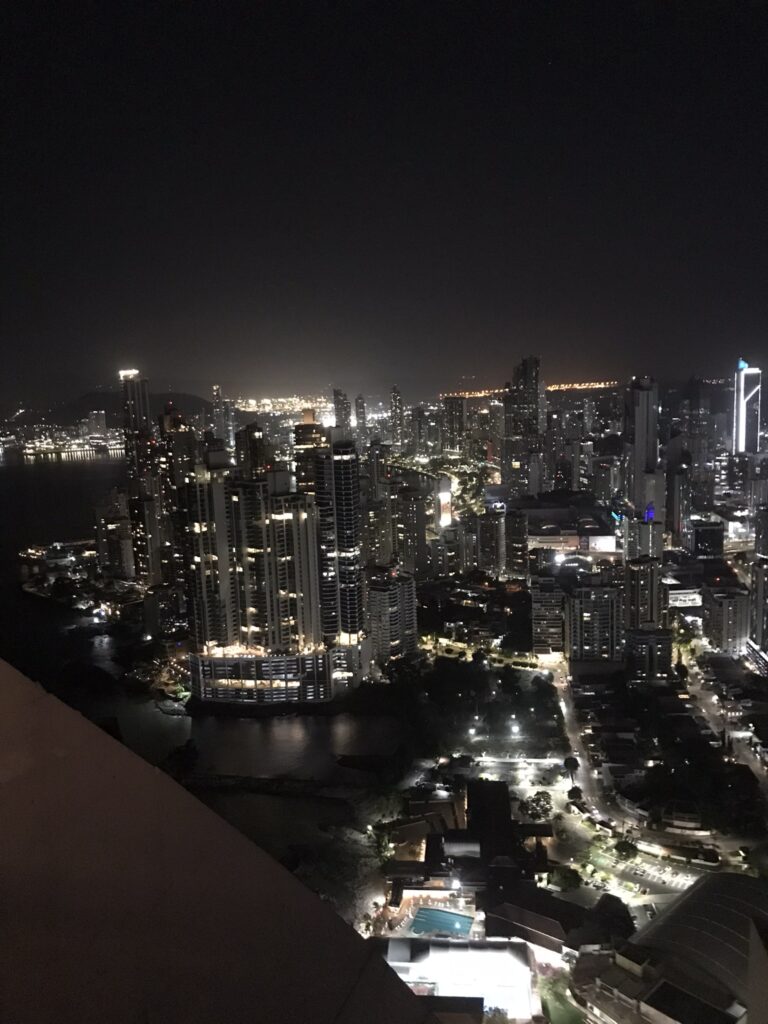
Looking down from the ex-Trump Tower in Panama City; the wealth of the city is visible from this vantage point.
Panama is an international business and trade transit hub. Major companies have their headquarters in Panama City, from well-known car manufacturers to banks and mobile networks. We counted more than 30 banks including the Bank of China, Scotiabank and other international banks with skyscrapers in the financial district. Panama has emerged as a leading logistical and financial centre. Part of the reason that Panama attracts so many foreign investors and companies is that their national currency, the Balboa, is pegged to the dollar. Dollars are used interchangeably throughout the country. We were also told that all international companies operating in Panama must have 90% Panamaians as employees, allowing for foreigners to make up only 10% of the workforce.
If I say Panama, the first thought in most people’s mind will be the Panama Canal. The history of Panama is intrinsically entwined with the building of the Panama Canal. Here’s a summary of the history:
Spanish explorers discovered that Panama was the narrowest point between the Pacific and Caribbean sea for the transfer of goods by land. Instead of taking the dangerous and arduous passage around the tip of South America, the Spanish opted to walk across Panama instead. The Spanish conquistadors moved gold and other precious items from ships docked on the Pacific Coast at Panama City across the isthmus of Panama to Portobelo on the Caribbean coast, from there ships would carry the treasures back to Spain. This was called the ‘camino real’ or royal pathway.
After the success of the Suez canal in Egypt, the French attempted to build a canal across the narrowest (50 miles wide) and least mountainous section of Panama in the late 19th century. However this project was beset with failures, over 20,000 French and Caribbean laborers lost their lives due to a high prevalence of yellow fever and malaria. The French engineers made the mistake of trying to level the mountains in the centre of the country which ultimately led to the abandonment of the project.
The USA took on the Panama Canal project after the French failed. With the support of the USA, Panama declared its independence from Colombia in 1903. Panama then signed a treaty with the USA which allowed for the construction of a canal and US sovereignty over a strip of land 10 miles wide and 50 miles long which was to be called the Panama Canal Zone. This land was essentially owned, administered and defended by American citizens and troops. The phrase used in the treaty was ‘in perpetuity.’ American engineers were more successful with constructing the canal as they built a series of locks over the mountains in the centre rather than trying to cut through them. More research had also been conducted on the cause and effects of malaria and yellow fever so fewer workers perished.
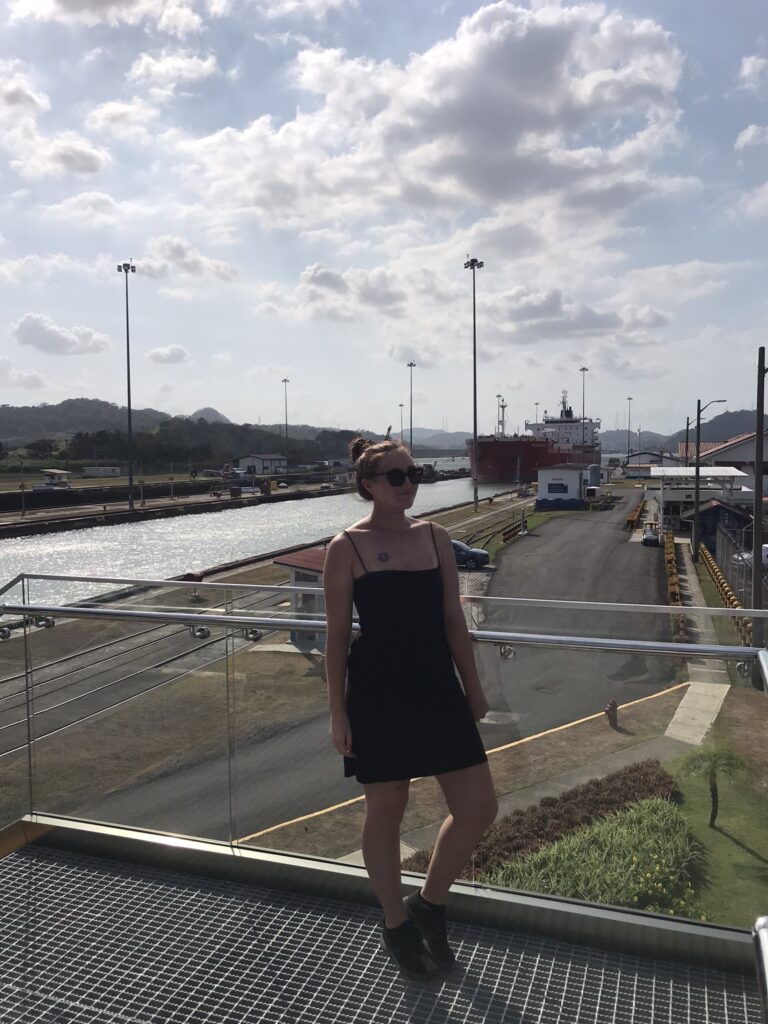
Officially opened in 1914, around 1000 ships pass through the Panama Canal each month carrying a total of over 40 million tons of goods—about 5 percent of global maritime trade
In 1978, President Jimmy Carter agreed to hand over control of the Panama Canal back to the Panamanians after a 21 year consultation period. On 31st December 1999, the Panama Canal was finally transferred back to the ownership of the Panamanians.
One thing that we found surprising was the amount of elderly American pensioners who’ve made Panama their home. We wondered why this was and came to the conclusion that various factors were in play.
- English is more widely spoken here than other countries in Central America.
- Dollars are accepted as the local currency
- Popular areas for retirees include Boquete, which has a temperate climate with temperatures not reaching over 30C.
- It’s a politically and economically stable country.
- It’s not overly expensive for housing and food when compared to other typical retirement hubs in America i.e. Florida.
- It has a history of welcoming foreigners, in particular Americans, due to the building and maintenance of the Panama Canal.
- Currently if you buy a property for over $300,000 you can automatically gain Panamanian citizenship.
Did you know that Panama doesn’t have a standing army? Panama has managed to avoid much of the civil strife that other countries in Latin America have experienced in recent history, with the exception of the 1980’s.
Boquete
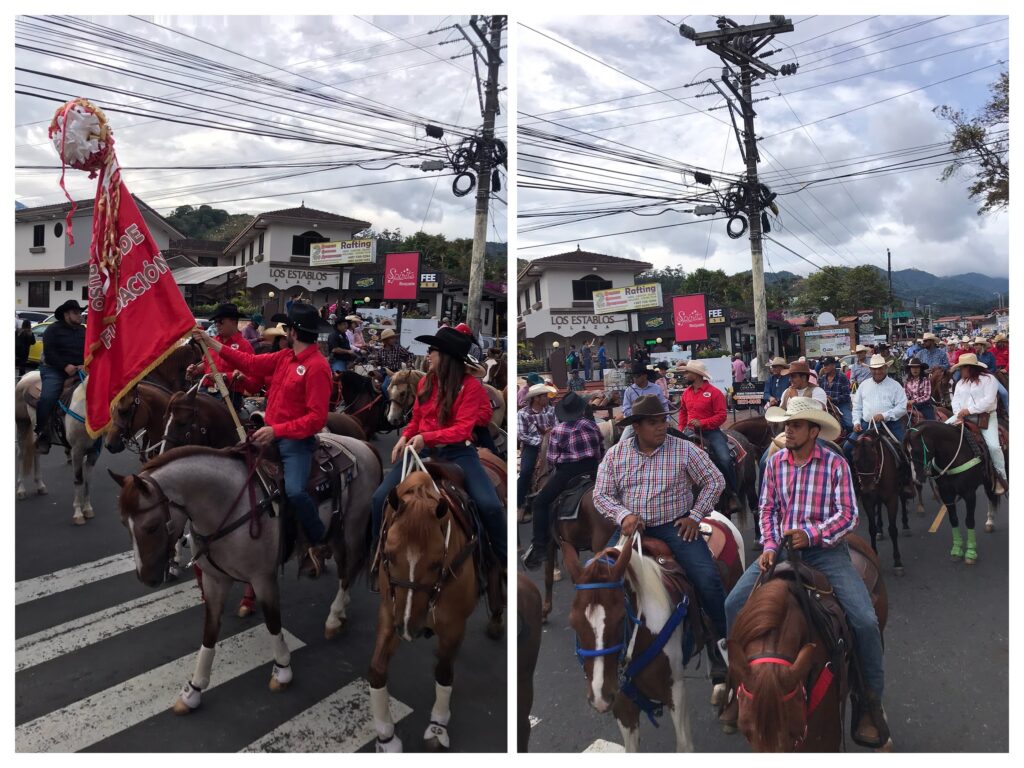
When we rolled into town on a chicken bus, or red devil as the locals call them, our driver decided to keep driving through the streets even though we were in the middle of what I can only call a ‘cowboy parade.’ Proud Panamanian ranchers sat atop perfectly groomed steeds, complete with stetson cowboy hats and boots. All were suited and booted in their cowboy-sunday best. It wasn’t just a masculine affair either with plenty of cowgirls and kids taking part in the ride along. And there wasn’t just one or two of these riders about, it was a continuous flood of man and beast as far as the eye could see up the main street. I’m still not sure why the chicken bus driver decided to keep driving through the parade. From the window of the chicken bus we watched the procession, occasionally getting the odd wave or smile from a cowboy. What a way to arrive in Boquete!
Nestled in the green mountain highlands at an altitude of 1,200m above sea level. Boquete is a tranquil oasis of lush green jungle, abundant walking trails, serene waterfalls and relaxing hot springs. If you’re looking to escape the heat and bustle of Panama City and embrace nature, Boquete should be on your travel list. Retirees flock to the area for the cooler weather and relaxed pace of life. It even has a country club for the expats! We noticed many American products lining the shelves of the supermarket including twinkies, Cap’n Crunch cereal and Campbell’s soup! We also noticed many locals wearing traditional indigenous dress whilst walking around the town centre. Boquete is part of Panama’s Chiriquí region with a strong indigenous influence.
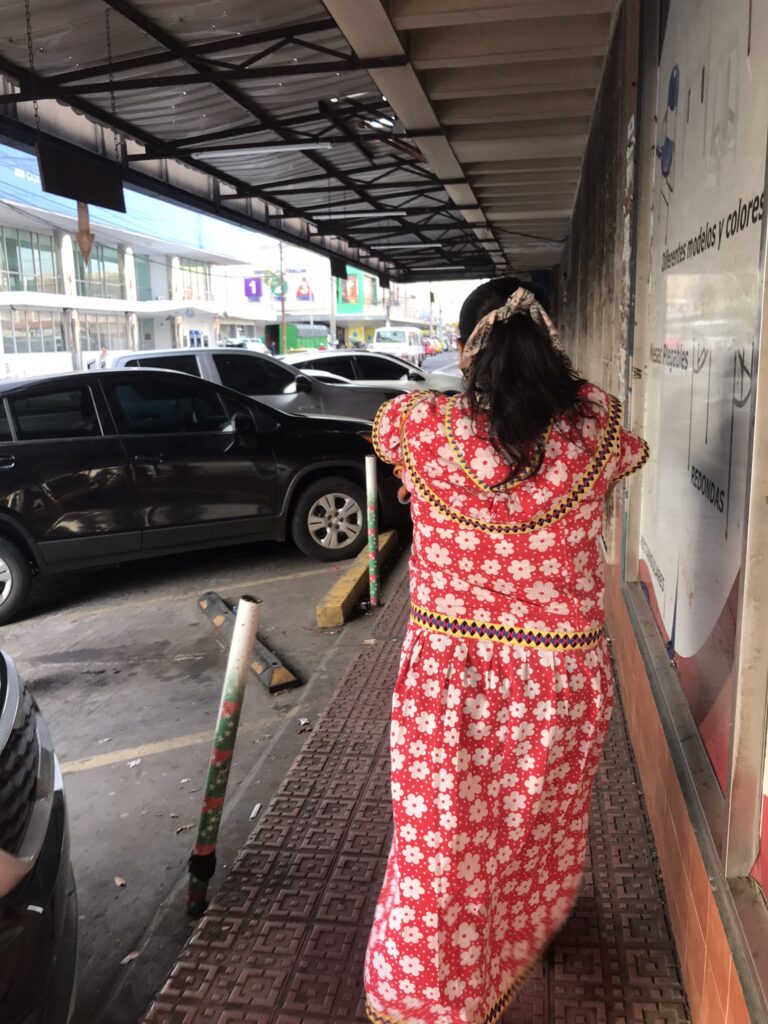
Taking a sneaky photo of a lady in indigenous dress
Boquete is the ideal place to take it easy, rest and relax in the cooler climes. For those who can’t sit still for long there are some hikes to keep you busy such as the Lost Waterfalls, Pipeline, El Pianista and Los Senderos Quetzales. Boquete is also known as a coffee mecca for aficionados. Here you can visit a coffee farm here or simply sit down with a geisha (not a Japanese person!), this super expensive strain came from Ethiopia and supposedly makes for the best cup of coffee. In the US, one cup of this coffee can be around $200.
David, the second largest city in Panama, is about an hour away. If you’re traveling east from Costa Rica to Boquete or heading onto Bocas del Toro or Panama City, you’ll need to transit through David to get to your next destination. The bus station is located here in David. There’s a separate section of the bus station for buses to Panama City here. Most people opt to get the night bus from David to Panama City (about 8 hours travel time depending on the traffic and time) however it’s possible to get buses throughout the day to Panama City. We decided to jump on the morning bus at 10am and arrived without issue to Albrook Bus Terminal in Panama City. David is the capital of the Chiriquí Province with Boquete, a smaller town in the same province.
Activities
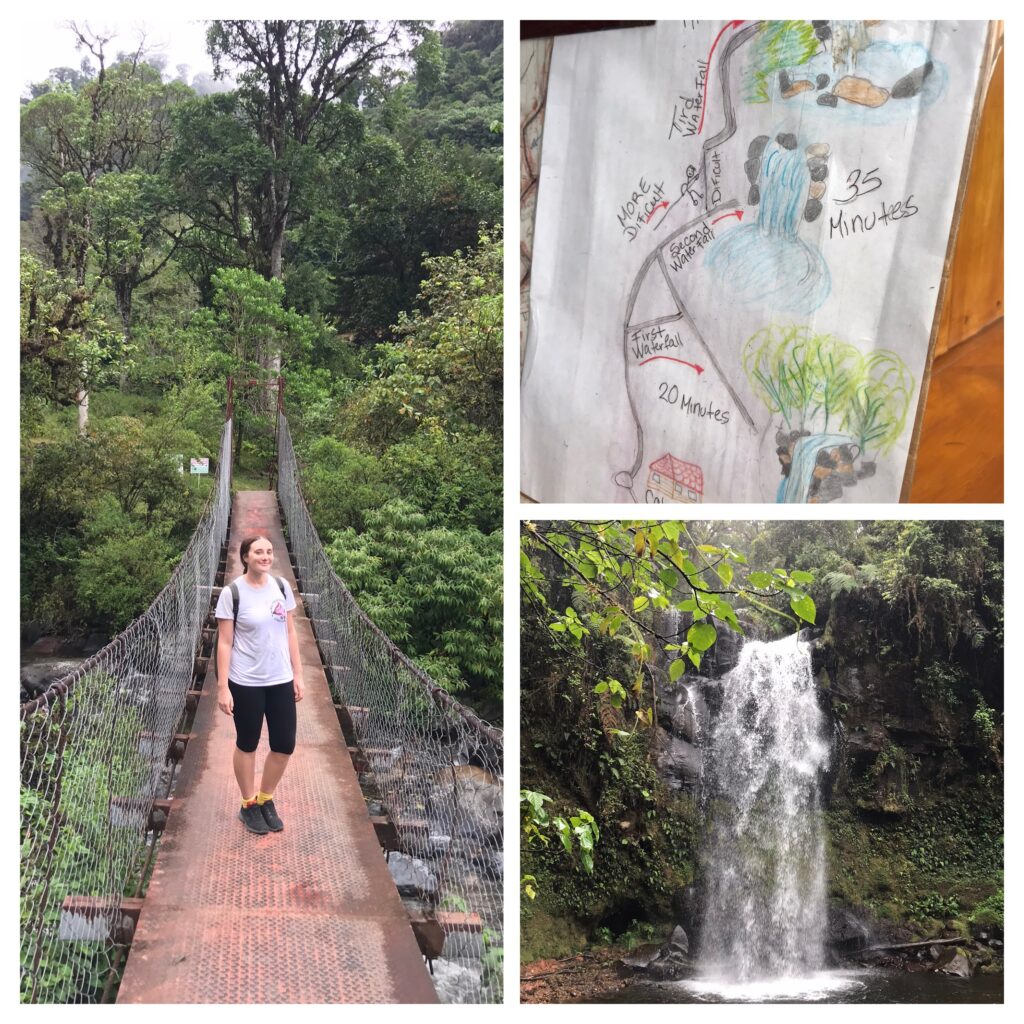
Scratch your hiking itch on the Three Waterfalls trek
The Lost Waterfalls Trek – Before undertaking this trek make sure you bring a rain jacket and some decent trainers or hiking boots. Even if it looks sunny outside, don’t be deceived, you may be surprised by an unexpected rain shower like us. If you forget to bring water or snacks, you can buy them at a stall near the entrance.The trail is quite muddy, especially if it’s the rainy season or there’s been recent rain in the area. To catch the shared minivan to the trailhead, head to this location opposite The Perfect Pair Coffee & Chocolate shop. We asked the closest minivan driver for ‘Las cascadas’ – the waterfalls and he told us to get in. The cost for the colectivo should be around $2.50 each way. The Lost Waterfalls trail is on private land so you have to pay a $10 entrance fee. Make sure you have enough cash for the minivan and entrance fee. It’s possible to swim in the second waterfall but the water is absolutely freezing, I only managed to put my foot in before wimping out. If you’re lucky there will be a minivan waiting where you got dropped off to take you back to Boquete.
Accommodation
Villa Alejandro – Boquete – we chose the junior suite and I can honestly say we found it difficult to leave the room. It was the perfect retreat for a couple of nights. Walking into the reception/lounge area felt like walking into a show home, everywhere was immaculate and tastefully decorated. There were so many appliances provided such as a juicer, toaster and coffee maker. Plus the free coffee in the room was delicious.
Foodie Places
Il arte del figlioccio – best pizza of the whole trip. This small, hole-in-the-wall pizza joint serves up authentic Italian pizza, freshly cooked right in front of your eyes in a wood fired pizza oven. They even offer free pesto oil which you can douse your pizza in. There’s some seating available but most people opt for a takeaway. The prices are fair and the pizza is phenomenal.
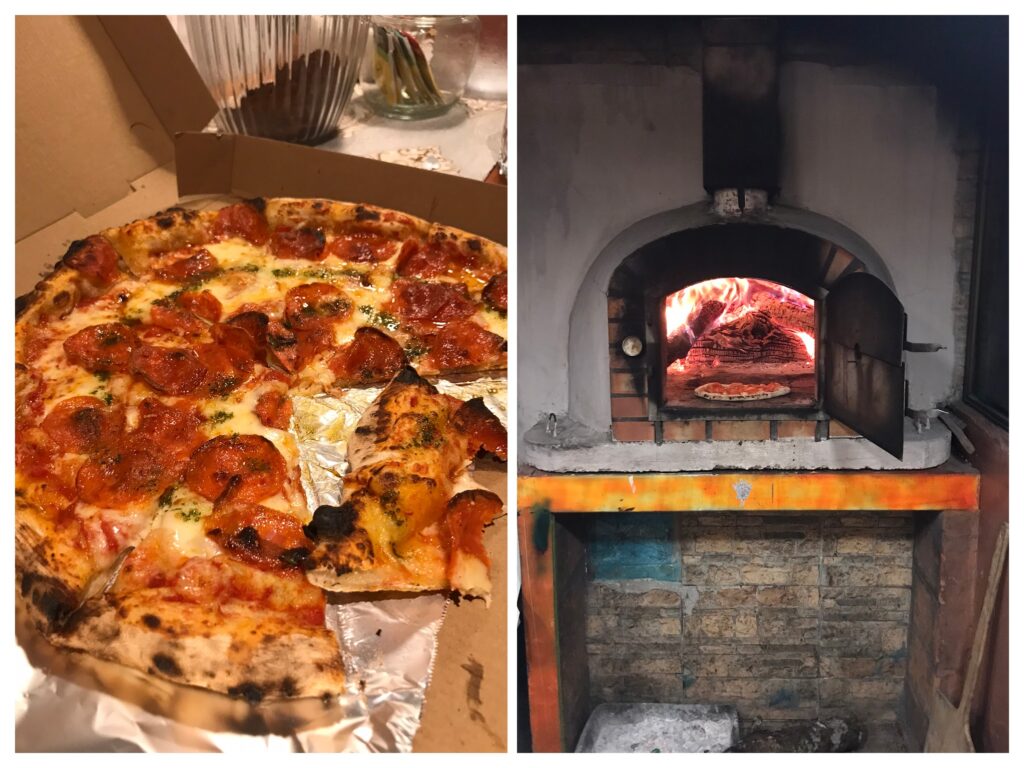
Staring into this wood-fired oven and eating pizza all day would be my dream job!
Panandaria Amalia – if you’ve got a craving for cinnamon rolls and don’t want to break the bank, head to this bakery to stock up on baked goods for under a dollar.
Sugar and Spice Boquete – This place isn’t just a café, it’s also a bakery and mini supermarket. With plenty of takeaway options and an extensive food menu, if you’re hungry this is the place to visit! They even sell homemade frozen soups for those craving vegetables in liquid form. The peanut butter fudge ice-cream is to die for!
Super Barú Boquete – our go-to supermarket in the town centre. There’s an extensive range of cheeses (yes, I spent about 20 minutes browsing in the cheese section) and baked goods section featuring fresh bakery products like mille fleur and baguettes.
Bocas del Toro
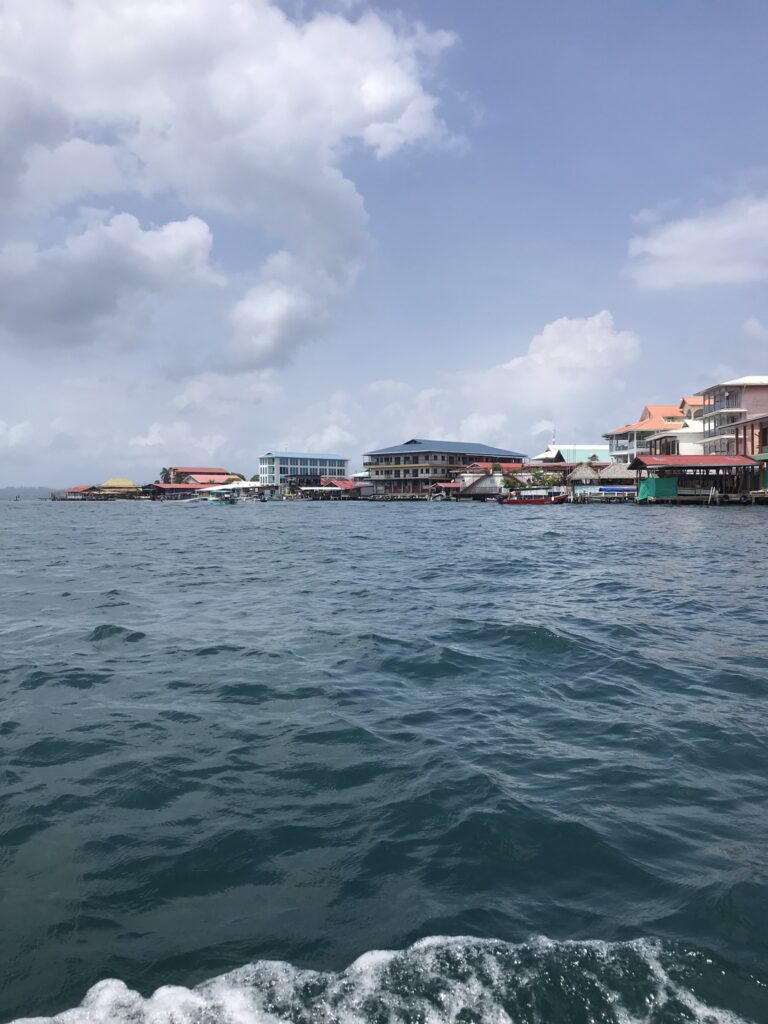
Bocas del Toro is a region in the northwest of Panama. It’s not just the island archipelago region for which it is best known, it also includes the Amistad National Park on the mainland. Bocas del Toro also happens to be the name of the main town in the archipelago, located on Colon Island which is where we stayed. Bocas del Toro town will likely be the first place you arrive, from there it’s possible to organise transport to Bastimentos (another popular island with a more relaxed reputation) and other less visited nearby islands. There are two mainland ports with frequent boats leaving for Bocas del Toro town, the most popular port is Almirante (served by frequent buses from David) whilst Chiriqui Grande is less well-known and more difficult to get to. We booked a shuttle from Boquete to Bocas del Toro and ended up using the Chiriqui Grande port. We didn’t actually expect this but the transfer went without a hitch.
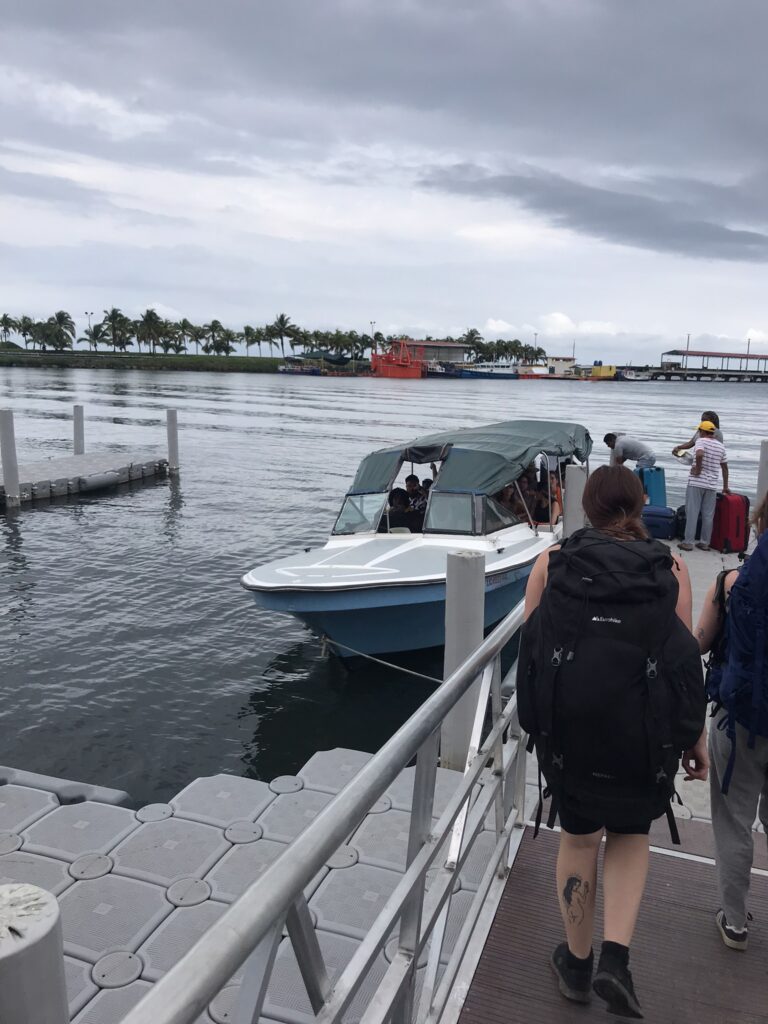
The boat was completely packed at Chiriqui Grande, uncomfortably so…
It would be easy to spend a full week visiting the stunning beaches on Colon Island (Drago, Starfish and Bluff beach) and Bastimentos (Red Frog and Wizard beach), snorkeling or diving in the crystal clear waters of the Caribbean sea and feasting on fresh caribbean seafood in Bocas town. It’s possible to catch a glimpse of some iconic mammals and birds in the jungle interior of Colon Island like howler monkeys. We even spotted a sloth close to Starfish beach.
Accommodation
Where to stay is one of the most important things to consider when visiting. Here is a summary of the pros and cons of each option.
Bocas town – As it’s the main town in the archipelago, don’t be surprised if you find yourself in the middle of some hustle and bustle. It’s the most populated area in the archipelago with plenty of restaurants, cafes, bakeries and souvenir shops. It’s easy to reach Drago, Starfish and Bluff beach from Bocas town by bus which cannot be said if you’re staying in a more remote area of the island. Expect some late night noise and disturbances if you’re staying at the weekend, especially if your hotel is on Calle 3a or 1a as this epicenter of the night-life scene. Some roads aren’t paved here, especially outside the main streets close to the pier, so when it rains expect a lot of muddy puddles and uneven ground.
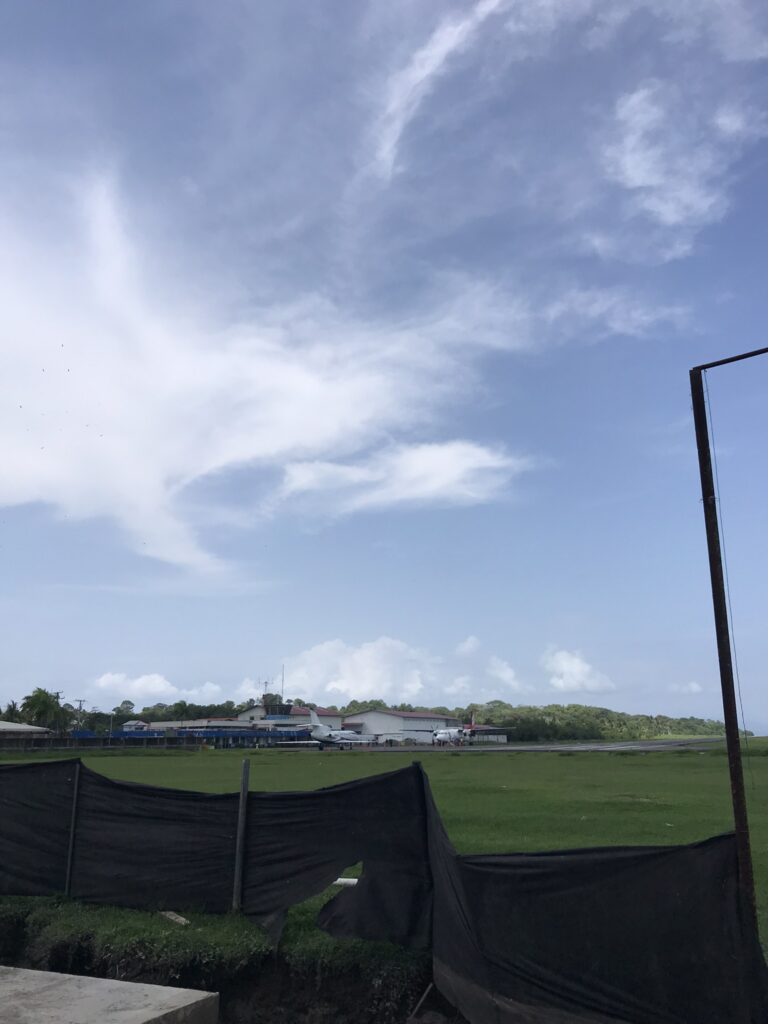
The air strip isn’t exactly secure, we saw some local kids playing football inside the grounds of the airport.
We opted to stay at Candyland which is a 15 minute walk from Simon Bolivar Park (where the buses leave for Drago beach). It’s very close to the airport; I panicked when I first saw this but it never bothered us as I think there’s only one flight a day. Each cute pastel-coloured wooden cabin had its own kitchen which was very useful when trying to save money, and most importantly the rooms had great air-conditioning! The area is primarily residential which meant we were far away from the ‘filthy Friday’ parties on the Bocas strip and able to sleep peacefully without any interruptions (this almost never happens!)
Drago Beach – We briefly considered staying here but when researching I discovered that the north part of the island is sometimes affected by electricity blackouts unlike Bocas town. We didn’t want to risk the air-conditioning not working so passed on this option. It’s easy to get the bus from Drago beach to Bocas town, however I believe the last bus departs from Drago to Bocas town at 6pm so you’d have to get a taxi back to Drago if you want to return later in the evening.
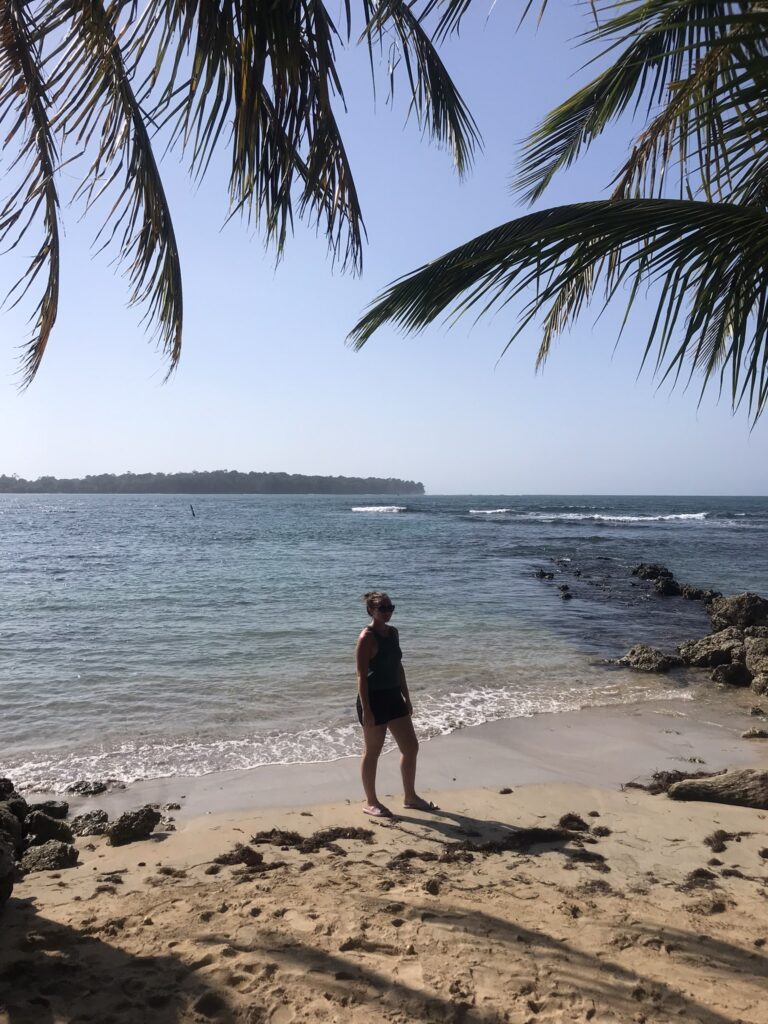
Drago beach is more isolated than Bocas town, you might even get the whole beach to yourself once the day-trippers depart.
At night you’re limited to the restaurants at Drago beach unless you want to splurge on a taxi to Bocas town. It’s more peaceful than Bocas town at night plus you can watch the sunset or sunrise on the beach.
Bluff beach – Again, you’re not in the middle of the action like Bocas town. If you’re looking to avoid the crowds of Bocas town and don’t mind limited food options this is a good option for you.
I can’t comment on Bastimentos as we didn’t visit, however after speaking to a resident we discovered that the islanders speak creole (a dialect of English) and that it’s quieter than Colon Island.
Foodie Places
La Fonda El Fruta de pan – if you’re looking for an authentic creole dining experience, this is it. With only 6 tables inside the wooden shack, you quickly get to know the duo that own the place. The chalk-board menu is crammed full of fresh seafood options like octopus, lobster, langoustines, shrimps and fish. We swear by the shrimps with patacones (fried plantain cakes) and rice.
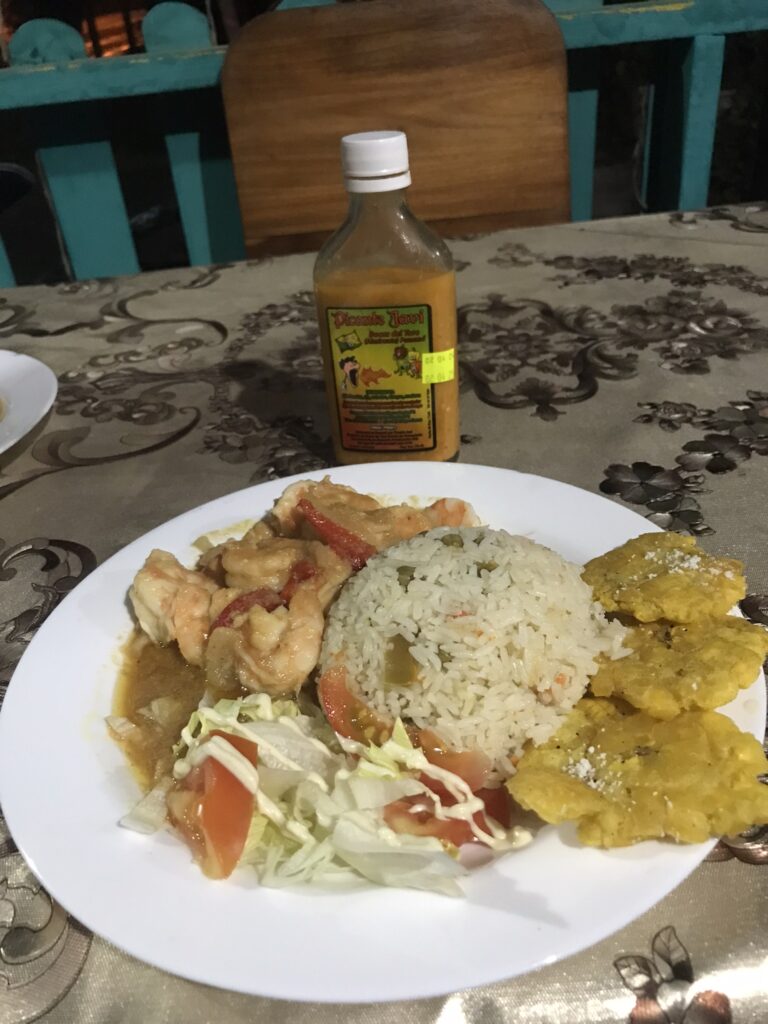
El Fruta de Pan also featured the tastiest hot sauce, made by a local friend of the owners.
Panis – an expensive minimalist bakery with bread to die for; literally because it’s so expensive (over $7 for a small cheese and tomato loaf) and it’s so goddamn delicious. As the Argentinian waitress said ‘It’s the best bread on the island.’ I can’t disagree with that assessment but you do have to pay a premium for it.
Activities
Drago & Starfish Beach – catch the bus here from Simon Bolivar Park to Bocas del Drago, the official name for Drago beach. The minivan will have a sign for ‘Drago’ on the front so keep an eye out for that. It’s best to arrive early to make sure you get a good seat, you don’t want to be the one standing up for the whole journey, almost falling over with each bend. Make sure you don’t miss the last bus back from Drago beach at 6pm as you’ll have to fork out for a taxi. There are plenty of restaurants lining the seafront at Drago beach with fantastic views over the azuline water. From Drago beach it’s possible to catch a boat to Starfish beach, or if you’re more adventurous you can walk by simply following the path between two houses and along the coast to Starfish beach. It takes roughly 20 minutes to complete the short hike from one beach to the other.
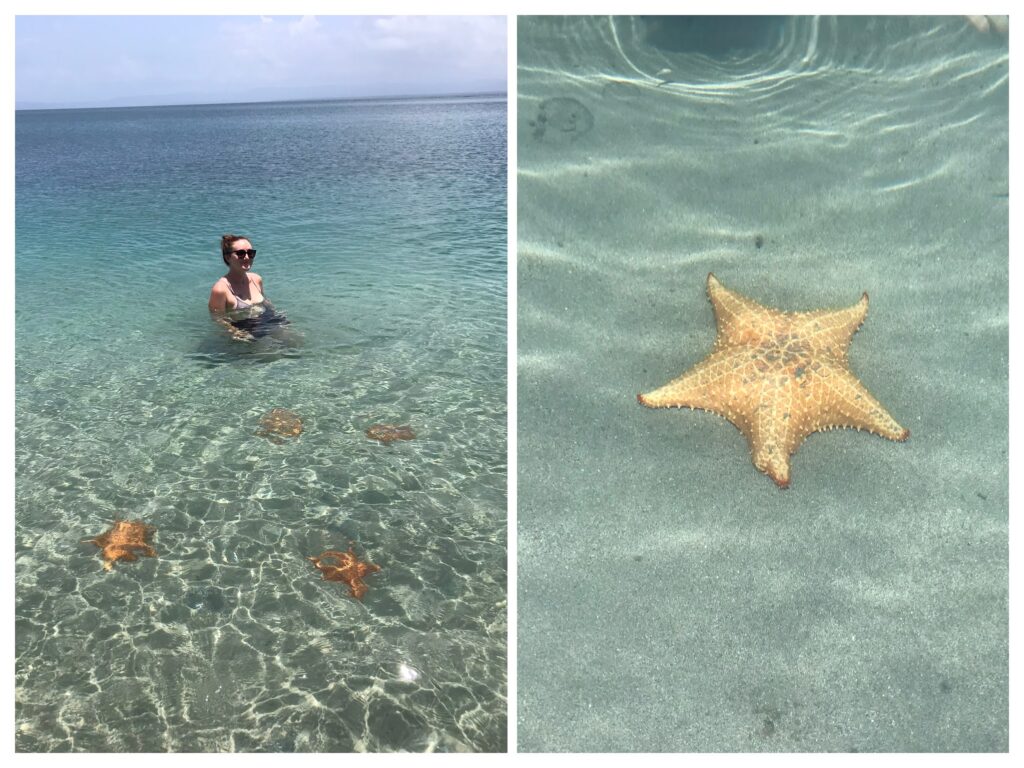
Frolicking in the sea with the starfish at Starfish Beach
We absolutely loved Starfish beach. The beach is as picturesque as any holiday advert beach and the sea is so calm and still, it’s the opposite of Copacabana beach in Brazil. The water is quite shallow and doesn’t drop down suddenly so it’s perfect for spotting the vibrant starfish in various shades of orange. The starfish were really visible and abundant here, at times it was difficult to swim in the shallow sea without having to avoid a starfish on the seabed. It’s very important that you don’t pick up the starfish and lift them out of the water as this could seriously harm or kill them. We spotted two tourists picking up the starfish and arranging them in a line underwater just for a photo op! Don’t do this please!
We spent hours skimming rocks and reclining in the sea to keep cool. If all the lazing around wasn’t enough, there are some beachside bars and restaurants serving delicious seafood and ice-cold beer. La dolce vita!
David
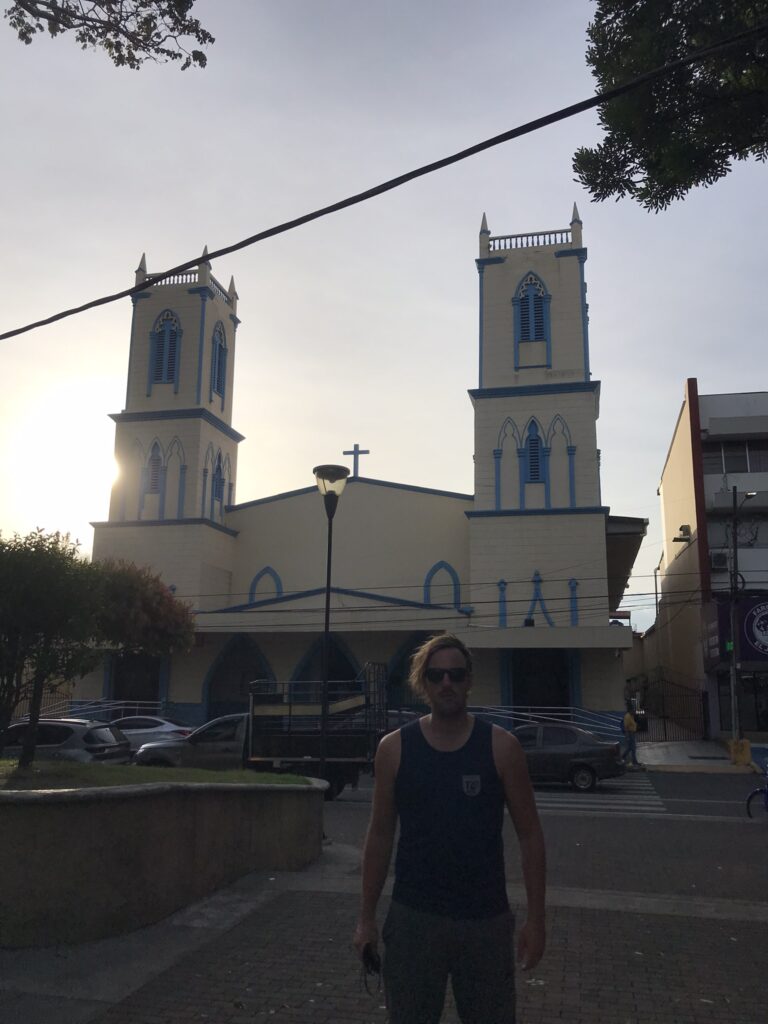
Miguel de Cervantes Saavedra Park in David
David, the second largest city in Panama, is about an hour away from the border with Costa Rica. If you’re traveling east from Costa Rica to Boquete or heading onto Bocas del Toro or Panama City, chances are you’ll need to transit through David to get to your next destination. The bus station is located here in David. There’s a separate section of the bus station for buses to Panama City here. Most people opt to get the night bus from David to Panama City (about 8 hours travel time depending on the traffic and time) however it’s possible to get buses throughout the day to Panama City. We decided to break up our journey from Bocas del Toro to Panama City by staying overnight in David and jumping on the morning bus at 10am. We arrived without issue to Albrook Bus Terminal in Panama City before dark and found it much more comfortable than getting the night bus.
David is the capital of the Chiriquí Province and, like in Boquete, the local indigenous dress is very visible here. David is a functional city with a wide array of shops and facilities, however outside of that we found that there wasn’t all that much to do in the city itself.
Accommodation
Hotel Alcala – a deceptively large hotel close to the bus station and city centre. The room was a little dated and had an old-style air-conditioning unit, however the unit worked well and the room and hotel was comfortable and clean.
Foodie Places
El Fogón – the portions here were huge! We were concerned that we’d somehow ordered two double meals because the portions were so generous. The food was tasty, service was very attentive and we just about managed to finish our meals but were completely stuffed afterwards (in a good way).
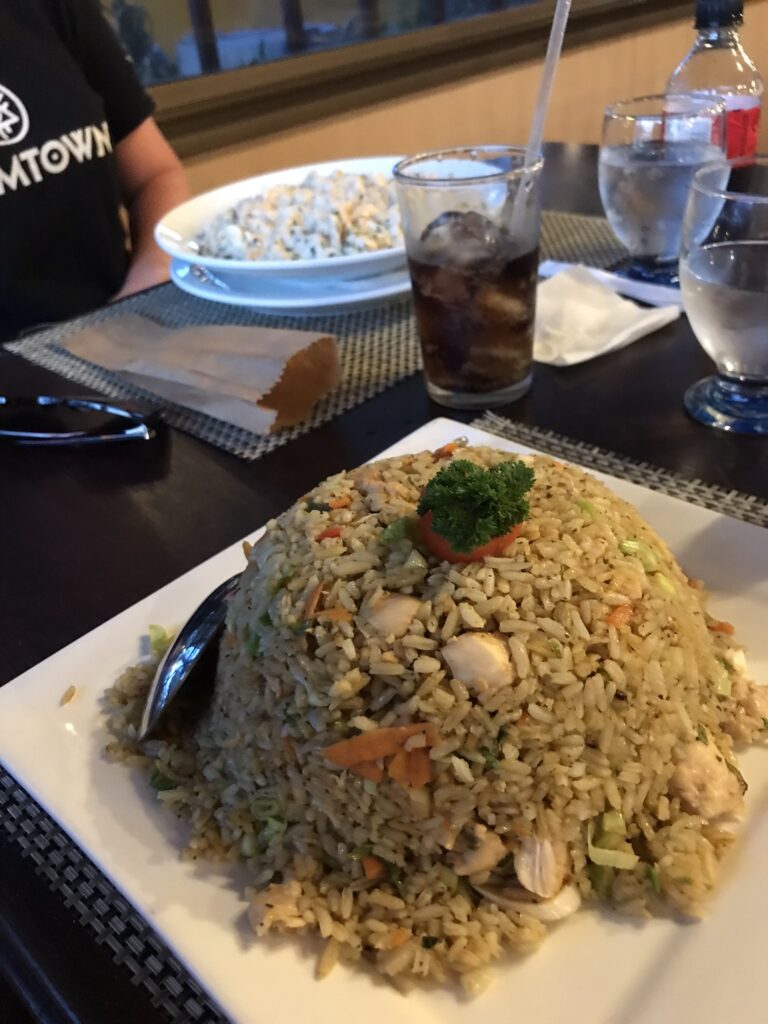
You can’t go wrong with a huge portion of fried rice at El Fogón
Panama City
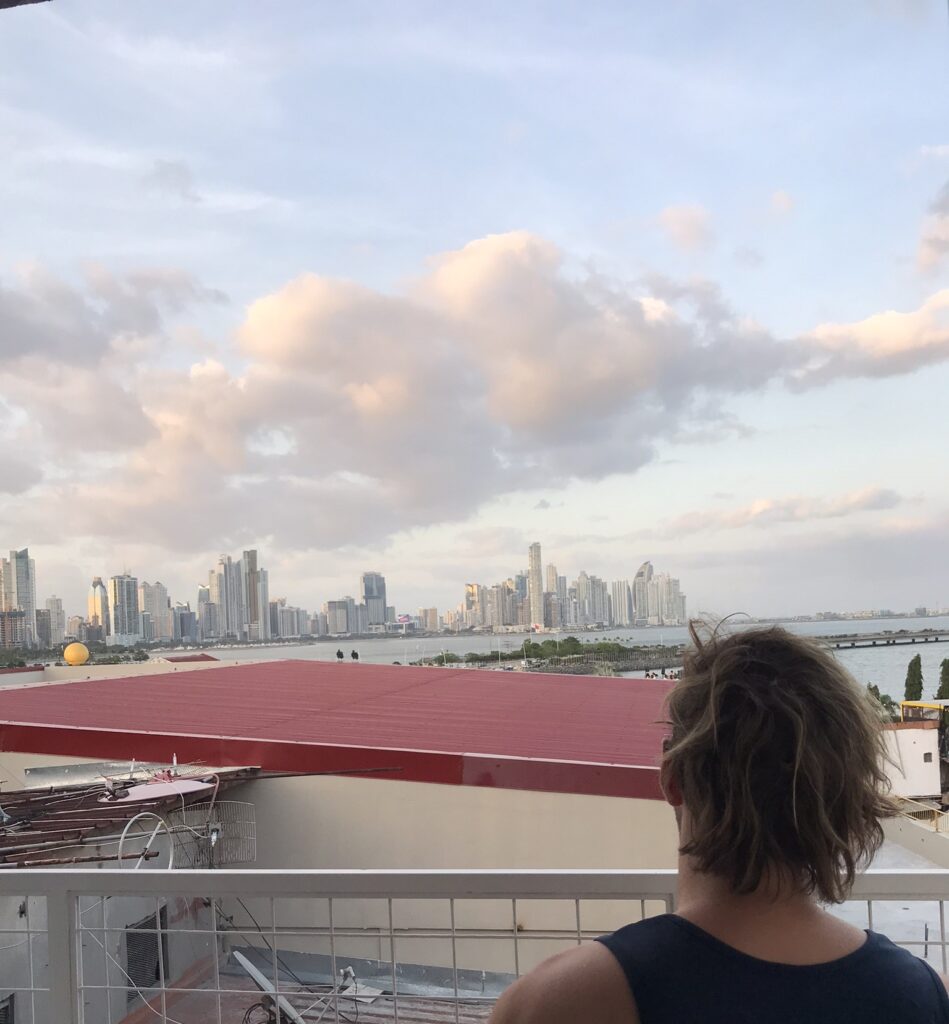
The view from our Santa Ana apartment in Panama City
Panama City is a playground for international businessmen, it’s situated along the ocean waterfront giving it a distinctly Miami-like feel. Once the sun goes down, the best views of the financial district can be seen from a rooftop bar in Casco Viejo. Panama City is ranked 27th in the world for the city with the most skyscrapers, just after Miami (26th). Beware that prices in Panama City, especially in Casco Viejo, are inflated for tourists.
Panamanians refer to Panama City as Panama, I’m not entirely sure why.
There are two main areas to stay in Panama City, the downtown area which includes the districts of Obarrio, San Francisco and El Cangrejo, and the original Spanish colonial settlement at Casco Viejo. You’ll inevitably end up in Casco Viejo; the picturesque, historic quarter, so I recommend staying here instead of downtown as it’ll save you navigating the subway or catching an Uber. We spent most of our time exploring Casco Viejo and if we needed to, we took an Uber to other attractions outside Casco Viejo.
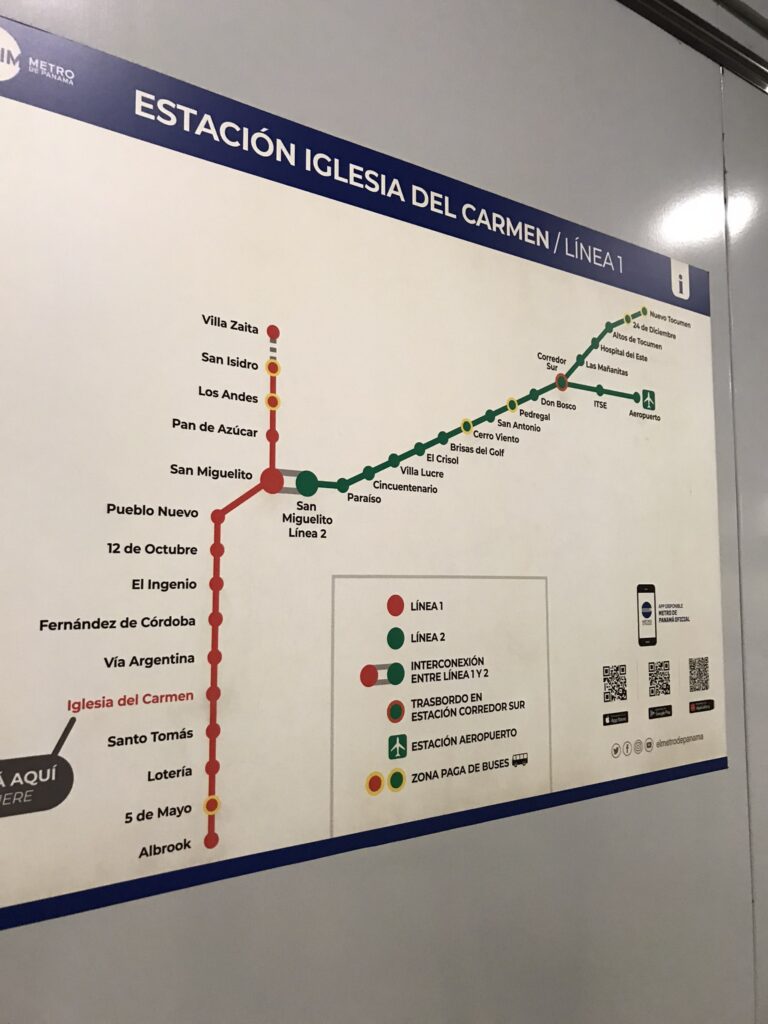
In case you want to brave the metro, we took a photo of the map.
Casco Viejo (Antiguo or old quarter in English) isn’t actually the oldest part of the city. The Spanish conquistadors originally founded Panama City in Panama Viejo, 10 miles up the coast from Casco Viejo. After an attack by the famous privateer Captain Henry Morgan in 1671 the old city was razed to the ground and moved to the more easily defensible spot where Casco Viejo now stands. Protective walls were built around the town however only a small section remains as the rest was destroyed during building work beginning in the 19th century. Casco Viejo is known for colonial architecture, stunning vistas of financial district skyscrapers, historic churches, glittering national theatre and relaxed plazas. It’s the beating heart of the gastronomic and nightlife scene in the city. If you want to party on the weekend, drink cocktails at a suave rooftop bar, drink geisha coffee in an ultra-modern coffee shop or try ceviche or other delightful seafood offerings in a top restaurant, Casco Viejo is the place to go. There are also many museums in Casco Viejo, although due to the high entry fees and time constraints we didn’t get a chance to visit. Both Casco Viejo and Panama Viejo are UNESCO World Heritage Sites.
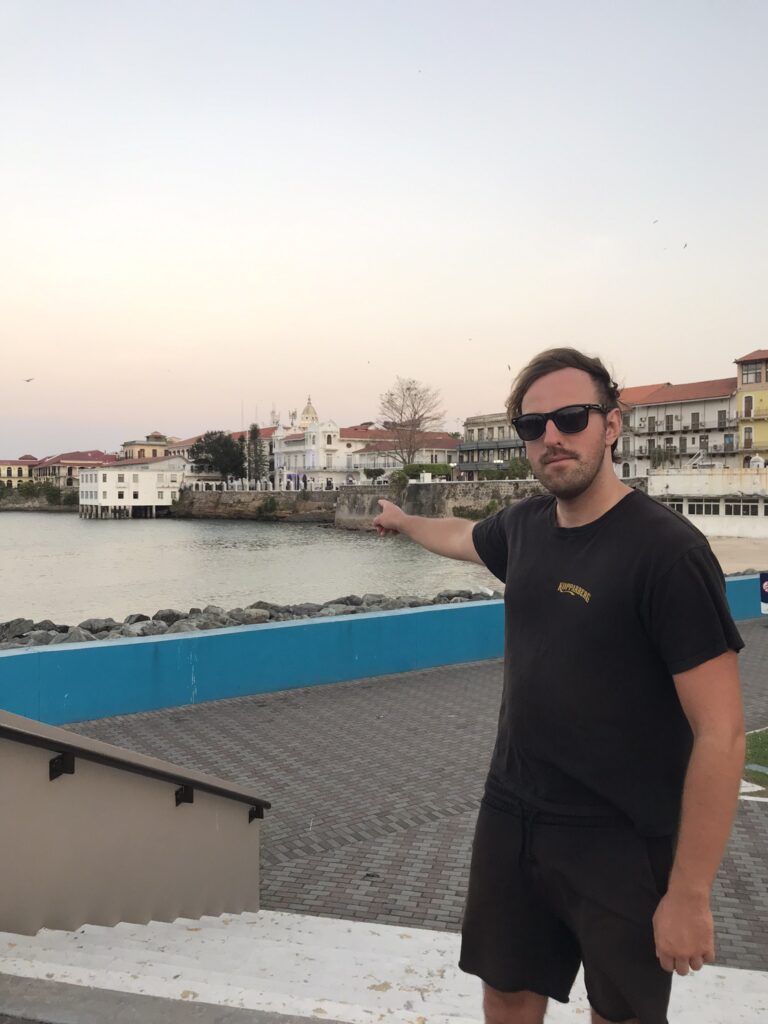
Dan pointing at the President’s House in Casco Viejo- access to the building is now blocked by police cordons.
Until the 1990’s, Casco Viejo was a crime-ridden neighbourhood, home to undesirables, criminals, low-income families and drug dealers. Frequent fires and the passage of time had not been kind to the colonial buildings, many of which were left in disrepair. Present-day Havana comes to mind. It’s still possible to see the destroyed husks of buildings waiting to be purchased, renovated and turned into a fancy hotel or Airbnb.
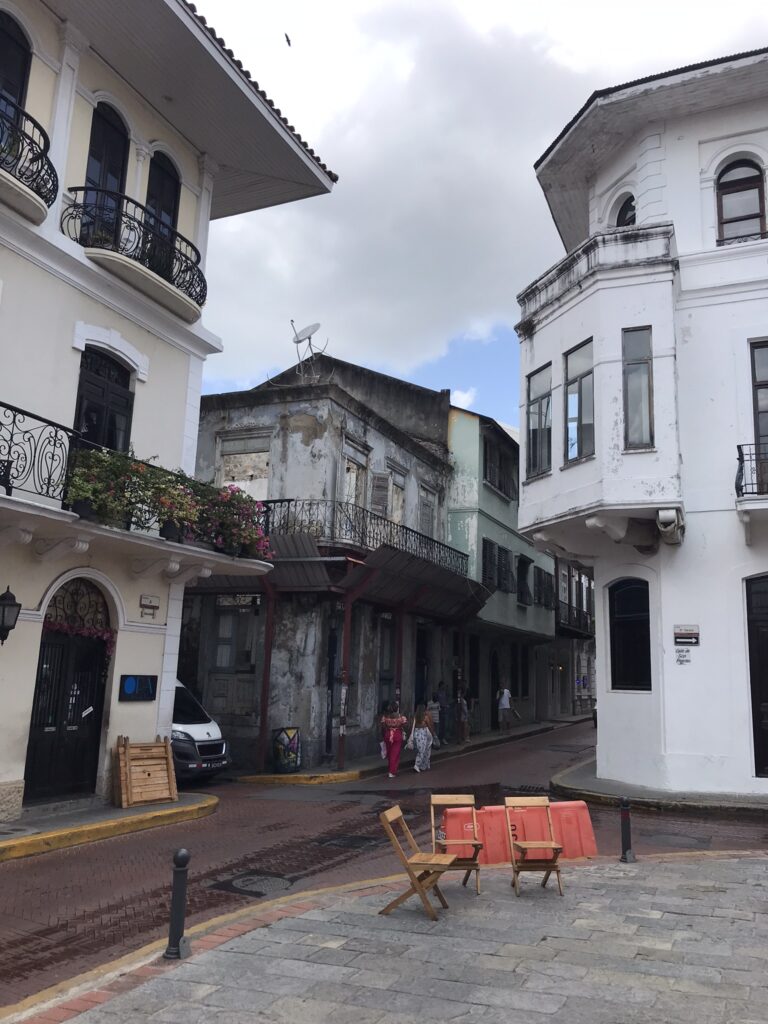
Derelict properties sit alongside newly renovated buildings in Casco Viejo
Starting in the 90s following the designation as a UNESCO site, Casco Viejo was cleaned up and rebranded as a tourist hotspot, with only a few disgruntled residents remaining as most others have been pushed out by gentrification. We saw posters protesting about the gentrification – rental prices have soared and local families find they are unable to afford these eye-watering price increases. As part of the UNESCO status only ⅙ of residents are protected and offered cost reductions on housing in Casco Viejo, the unlucky ⅚ find themselves unable to afford to live in their homes anymore and forced to leave. The remaining residents of Casco Viejo are easy to spot amongst the hordes of wealthy tourists and fancy restaurants, leaving Casco Viejo as a place full of contradictions.
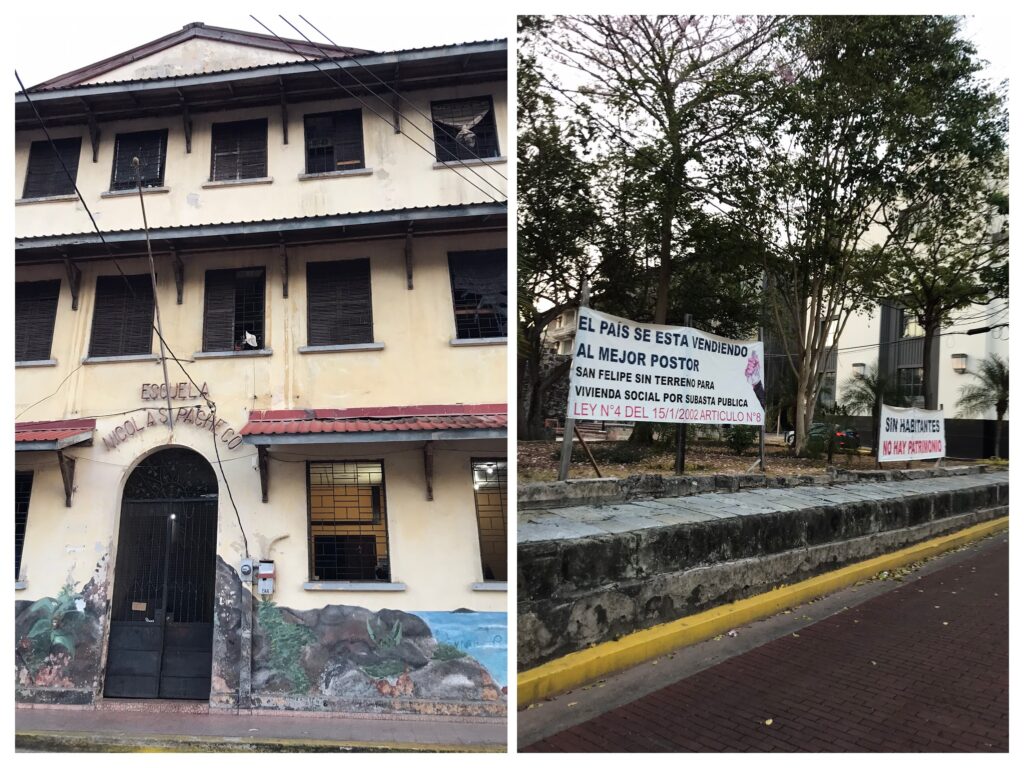
Residents have refused to move out of this abandoned school in their fight against being rehomed outside of Casco Viejo
Uber works well in Panama City, it’s very easy and relatively cheap to get to most visitor attractions including Panama Viejo and the Panama Canal. There is also a metro in Panama City, however this is relatively new and doesn’t yet reach Casco Viejo or the main tourist areas.
Most, if not all, national buses in Panama City will arrive at Albrook Bus Terminal – it’s a mega bus terminal with a shopping mall and numerous restaurants inside. It also has free wifi which is a huge plus for budget travellers without a SIM card or data. The area around Albrook doesn’t have the best reputation so it’s recommended to get an Uber to or from the station.
Activities
Panama Canal Miraflores Visitor Centre – Visiting the Panama Canal is a quintessential activity in Panama – after all, it is the main reason for the country’s independence and much of its wealth. The easiest way to visit the canal is by heading to the Miraflores Visitor Centre, which is easily accessible from Panama City by Uber. Here you can learn about the canal and watch passing boats from a viewing area, often accompanied by an enthusiastic commentator. It was fascinating to observe how the lock works and to see huge cargo ships slowly lowering to a lower water level. There are two separate viewing platforms to watch ships pass through the lock. As the ship gets closer to the viewing platform you can see the workers on the deck in hi-vis, we gave them a friendly wave. Be aware that ships don’t pass through this stretch of canal during the middle of the day, so the afternoon is the best time to visit. We were surprised to hear how much money it costs to pass through the Panama Canal, around $1 million for some ships.
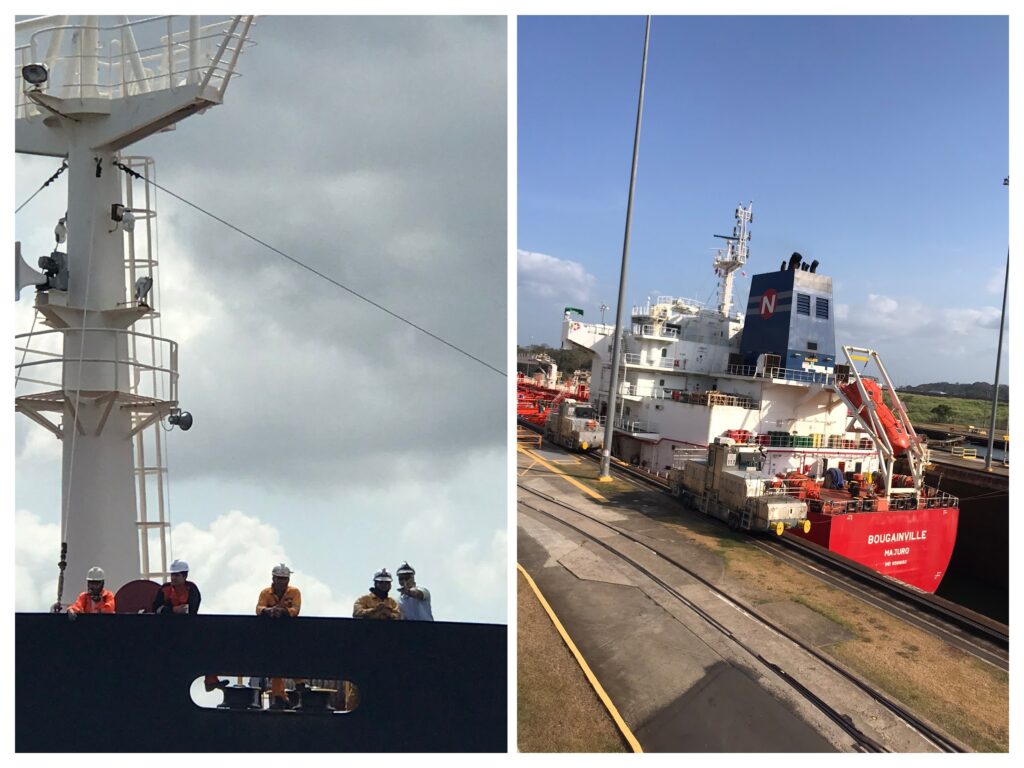
We couldn’t resist giving the crew a wave on a passing cargo ship
There’s also an IMAX cinema at the visitor centre showing the aptly named movie, A Land Divided, narrated by Morgan Freeman. It gives a great general overview of the history of Panama and the Panama Canal. And it’s in 3D! The auditorium is massive so finding a seat shouldn’t be a problem. It’s possible to buy popcorn, slush (ice blast) and various cinema snacks near the auditorium. Be prepared to feel like you’re back home at your local cinema with the sweet smell of popcorn and nachos with gooey cheese.

The movie was a great touch adding to the whole experience
Guruwalk walking tour of the Casco Viejo neighbourhood – particular places of interest include the Cathedral, National Theatre, Simon Bolivar Plaza, France Square, the Street of the Hats, San Francisco Church, Church of Saint Joseph, Mola Museum, Arco Chato and Paseo Esteban Huertas.
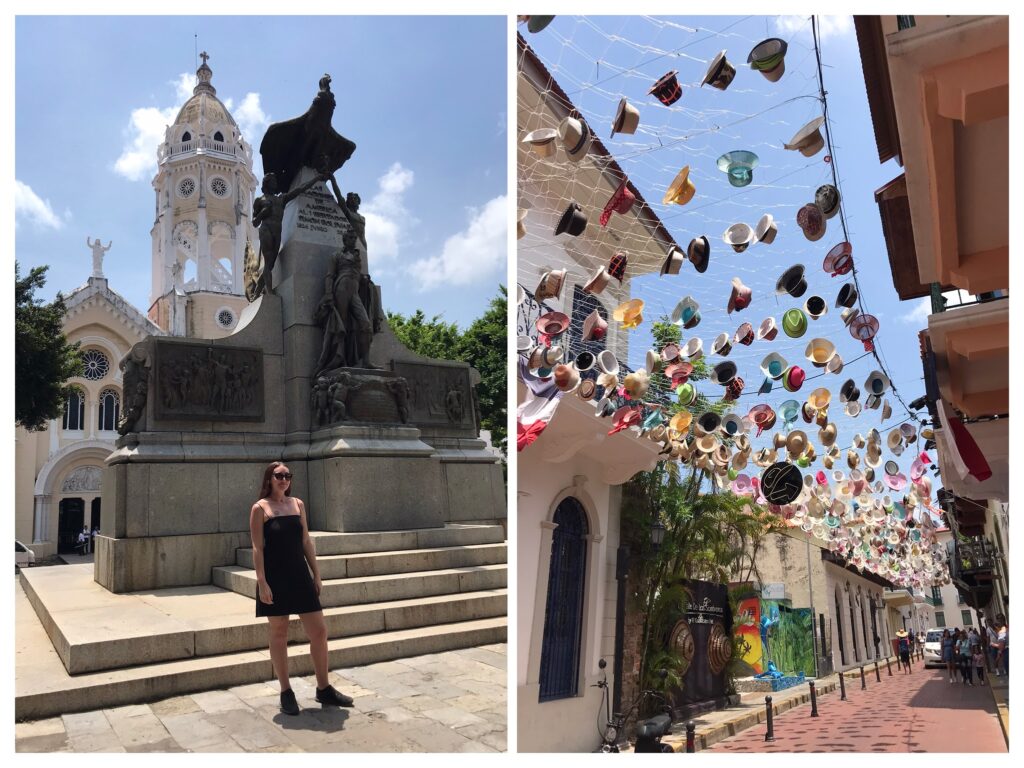
Simon Bolivar memorial and Street of the Hats in Casco Viejo
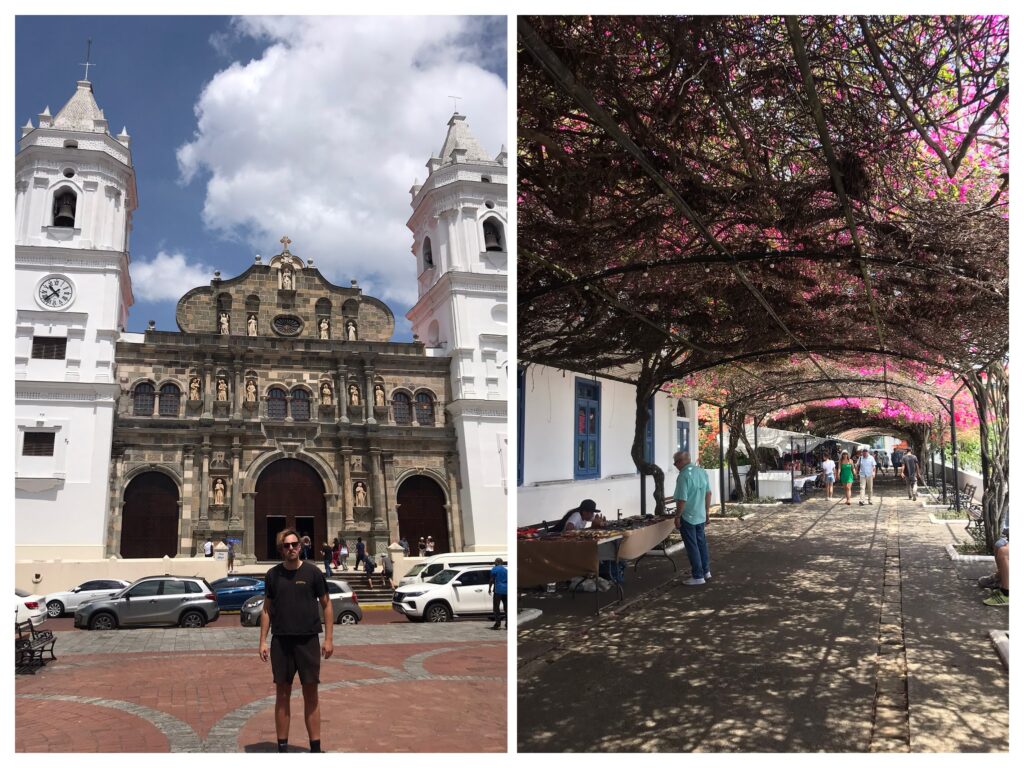
The Cathedral ft Dan and Paseo Esteban Huertas
Get out of Casco Viejo – Modern city Panama walking tour with Jose – we really enjoyed seeing another side to Panama City. The walk began in Casco Viejo and then onto Santa Ana (a lower-class neighbourhood), afterwards we took the metro to the modern financial district dotted with skyscrapers, then onto the seafront and finally finishing at the skybar on the 66th floor of the ex-Trump tower. The walking tour guide, Jose, was very friendly and chatty, willing to explain everything he knew about the city and different areas. Be very careful around the metro stations as a couple from our group were almost robbed at the subway entrance.
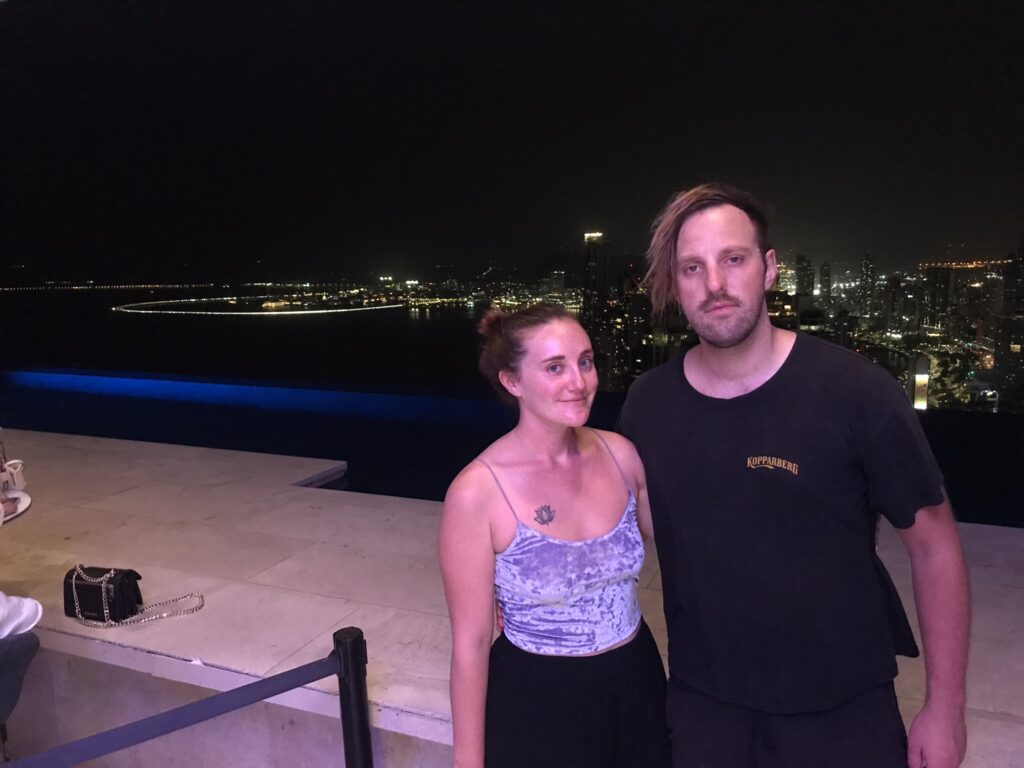
One of the tallest skyscrapers in the city; the JW Marriott Hotel was formerly the Trump Tower
Panama Viejo – It’s quite a long way from Casco Viejo but well worth a visit, you can get there by Uber and there is free wifi at the entrance so you can also get an Uber back. To enter the site you will need to head to the Centro de Visitantes de Panama Viejo and then either walk or take a free shuttle to the site itself. The on-site museum explains pre-Columbian history, the chronology of the Spanish conquest, how the settlement of Panama Viejo developed over time (including a fantastic model town), daily life of the merchants and wealthy townsfolk who called Panama Viejo home, religious art and finally how Captain Henry Morgan was able to attack the town and cause it’s demise. The ruins of Panama Viejo are quite impressive, especially the Church tower, which is still standing after restoration efforts.
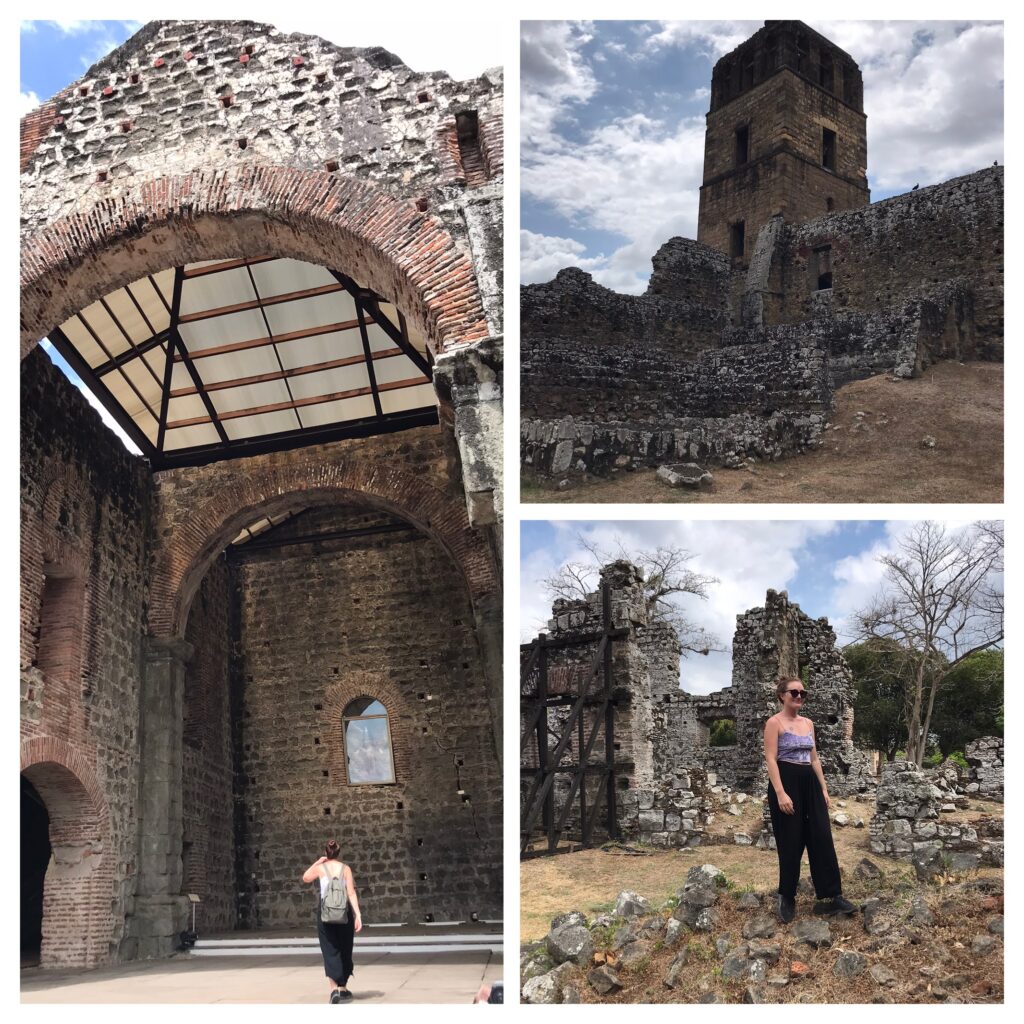
At Panama Viejo you can really get a sense of what each building was and its purpose back in the 17th century.
Mola Museum – This museum has free entry. Molas are traditional fabrics crafted by the indigenous communities of the San Blas region. Women use an applique method to create a layered colour effect, designs feature animals, people, daily life and geometric shapes. The museum explains how women create these molas, what subjects they feature and indigenous beliefs about the world. We even spotted a spiderman mola on display!
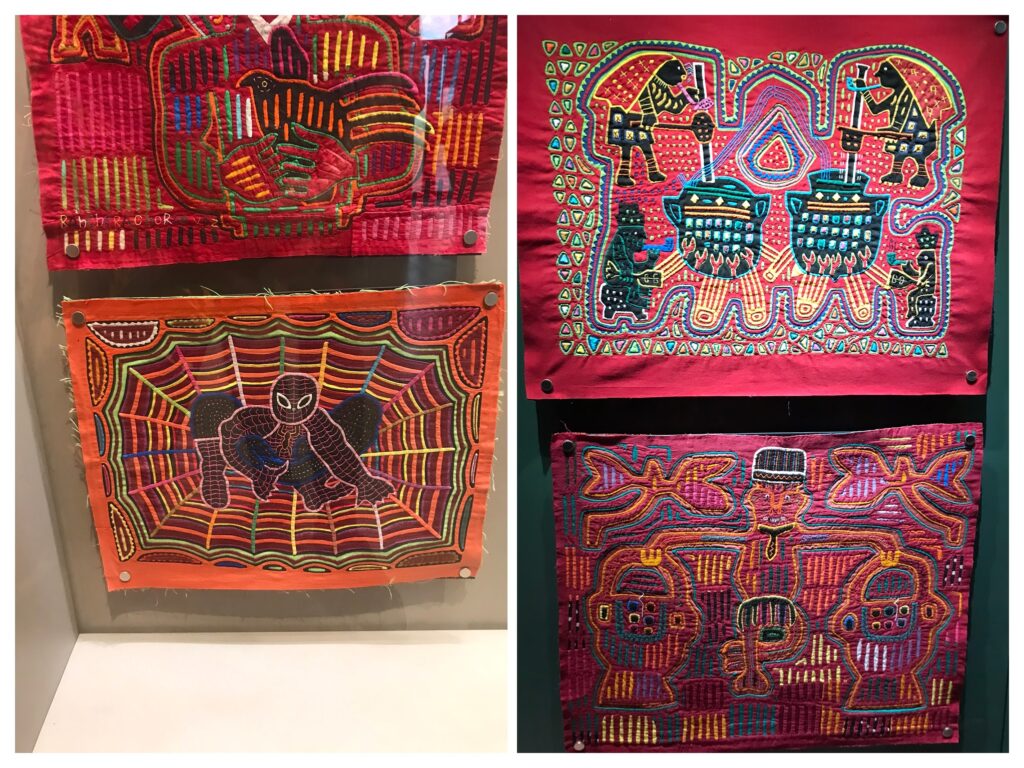
Molas are so intricate and colourful
Accommodation
La Moderna Luxury Apartments, by Wynwood House – technically in Santa Ana instead of the Casco Viejo neighbuorhood. Not a budget option however we got a good deal here on Airbnb and the apartment was fantastic with unbeatable views over the skyline, fully equipped kitchen and modern interior design. The apartment block is close to some rooftop bars so whilst it isn’t silent at night it wasn’t as noisy as we’d expected for a Saturday night. It also happens to be close to the Selina hostel and supermarket.
Foodie Places
When we breezed into Panama City it was the last stop of our 4-month trip so we didn’t indulge in many fancy meals or cafe lunches, particularly because of the high prices in Casco Viejo. As we had a kitchen in our Airbnb, the supermarket became our regular go-to for food.
La Pulpería – Casco Antiguo – we had mixed feelings about this place. It had a rating of 4.9 on Google so we gave it a go. We had very high expectations because of the reviews and menu prices. Dan ordered the octopus at around $18 and although it tasted great, the portion size was tiny and we left hungry. In hindsight we wouldn’t go here again because the price to quantity ratio wasn’t great, even though the quality of the food was good.
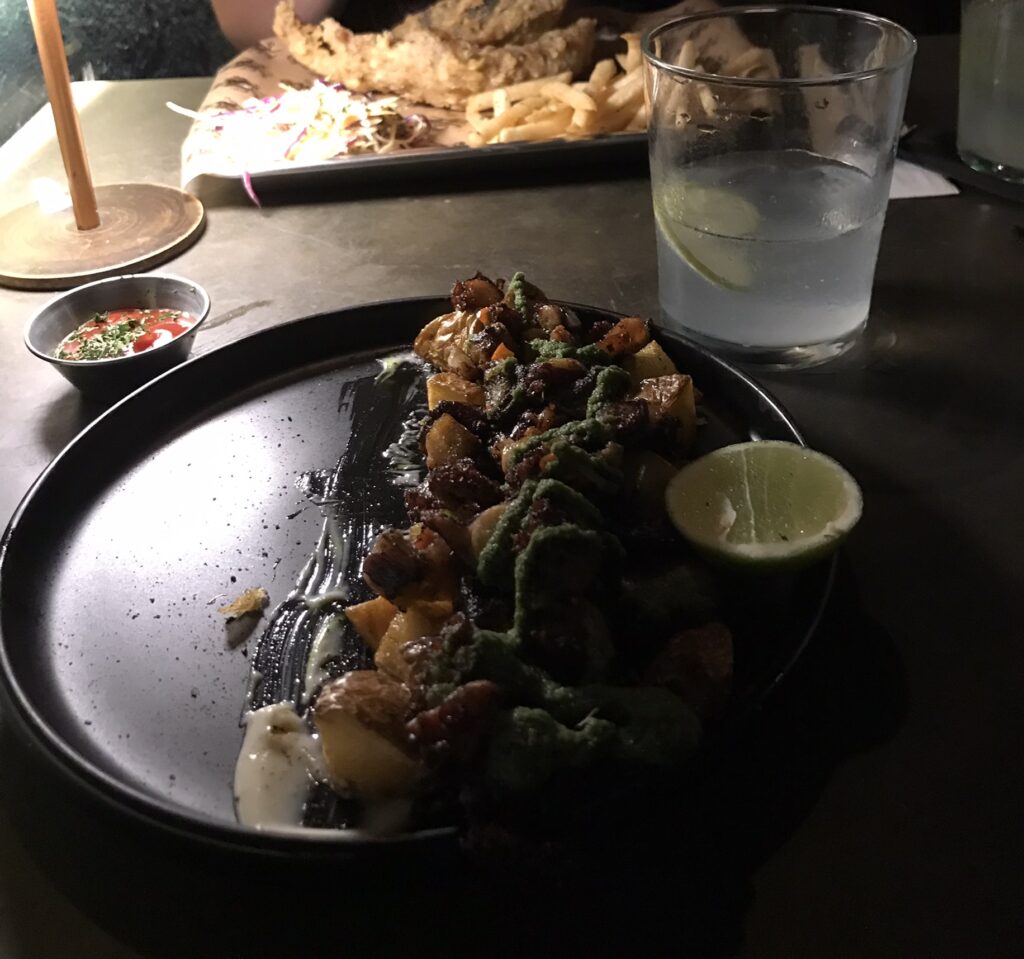
Dan’s tasty but measly portion of octopus and roasted potatoes
El Machetazo Santa Ana – a well-stocked supermarket with the best prices in the area.
We were warned not to have ceviche at the Fish Market (Mercado Mariscos) as they use young sharks instead of fish. However I can’t comment on the accuracy of this.
My Panama City content is now available on GPSmyCity!
